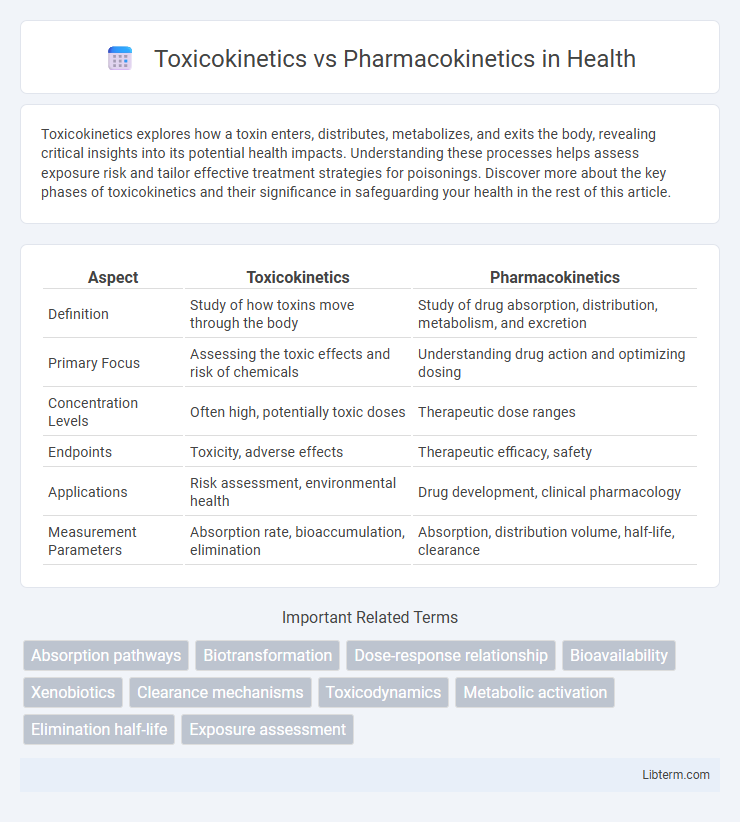Toxicokinetics explores how a toxin enters, distributes, metabolizes, and exits the body, revealing critical insights into its potential health impacts. Understanding these processes helps assess exposure risk and tailor effective treatment strategies for poisonings. Discover more about the key phases of toxicokinetics and their significance in safeguarding your health in the rest of this article.
Table of Comparison
| Aspect | Toxicokinetics | Pharmacokinetics |
|---|---|---|
| Definition | Study of how toxins move through the body | Study of drug absorption, distribution, metabolism, and excretion |
| Primary Focus | Assessing the toxic effects and risk of chemicals | Understanding drug action and optimizing dosing |
| Concentration Levels | Often high, potentially toxic doses | Therapeutic dose ranges |
| Endpoints | Toxicity, adverse effects | Therapeutic efficacy, safety |
| Applications | Risk assessment, environmental health | Drug development, clinical pharmacology |
| Measurement Parameters | Absorption rate, bioaccumulation, elimination | Absorption, distribution volume, half-life, clearance |
Introduction to Toxicokinetics and Pharmacokinetics
Toxicokinetics examines the absorption, distribution, metabolism, and excretion (ADME) of toxins and hazardous substances in the body, providing critical data for risk assessment and safety evaluation. Pharmacokinetics focuses on the same ADME processes but pertains specifically to therapeutic drugs, guiding dosage and efficacy optimization. Understanding both fields enables accurate prediction of substance behavior and informs clinical and toxicological decision-making.
Defining Toxicokinetics: Core Concepts
Toxicokinetics studies the absorption, distribution, metabolism, and excretion (ADME) of toxic substances to understand their movement and concentration in the body over time. It quantifies exposure levels and evaluates how chemicals interact with biological systems, emphasizing dose-response relationships that determine toxicity. Differing from pharmacokinetics, which focuses on therapeutic drugs, toxicokinetics centers on harmful agents and their impact on health risk assessment and toxicological profiling.
Understanding Pharmacokinetics: Key Principles
Pharmacokinetics involves studying the absorption, distribution, metabolism, and excretion (ADME) of drugs to understand their behavior within the body. Key principles include bioavailability, half-life, volume of distribution, and clearance, which help determine dosage and therapeutic efficacy. Toxicokinetics shares these principles but focuses on the body's processing of toxic substances, emphasizing safety assessment and risk management.
Comparative Overview: Toxicokinetics vs Pharmacokinetics
Toxicokinetics and pharmacokinetics both describe the absorption, distribution, metabolism, and excretion (ADME) of substances, but toxicokinetics specializes in understanding the behavior of toxicants and their dose-response relationships in the body. Pharmacokinetics primarily focuses on therapeutic drugs, optimizing efficacy and minimizing adverse effects through drug concentration monitoring over time. Both disciplines utilize modeling and experimental data, yet toxicokinetics emphasizes toxic threshold levels and exposure risks, while pharmacokinetics centers on therapeutic windows and drug safety profiles.
Absorption Pathways: Similarities and Differences
Toxicokinetics and pharmacokinetics both study absorption pathways, focusing on how substances enter systemic circulation, primarily through passive diffusion, active transport, and endocytosis. Toxicokinetics emphasizes absorption mechanisms for harmful chemicals, often considering factors like dose-dependent saturation and tissue-specific barriers, whereas pharmacokinetics investigates therapeutic drugs with attention to optimized bioavailability and controlled release. Differences arise in the intensity and context of absorption, where toxicokinetics may involve non-selective uptake and higher variability due to toxicant properties compared to the more predictable and regulated absorption profiles in pharmacokinetics.
Distribution Patterns: Toxic vs Therapeutic Agents
Distribution patterns of toxicokinetics involve the accumulation of toxic agents in specific tissues, often leading to higher concentrations in organs like the liver, kidneys, or brain, which can cause localized toxicity. In pharmacokinetics, therapeutic agents are distributed systematically with controlled plasma protein binding and tissue permeability to achieve effective drug concentrations while minimizing adverse effects. Understanding these differences enables accurate prediction of toxic versus therapeutic doses, optimizing treatment safety and efficacy.
Metabolism: Detoxification vs Drug Processing
Toxicokinetics primarily involves the metabolism of harmful substances through detoxification pathways such as Phase I and Phase II reactions to neutralize toxins and facilitate their excretion. Pharmacokinetics focuses on drug processing, including absorption, distribution, metabolism, and elimination, emphasizing biotransformation by enzymes like cytochrome P450 to optimize therapeutic effects and minimize toxicity. Understanding the distinct metabolic pathways in both fields aids in predicting the safety profile of chemicals and pharmaceuticals.
Elimination Mechanisms: Clearance in Both Fields
Clearance in toxicokinetics refers to the body's ability to eliminate toxic substances through metabolic transformation and excretion, primarily via hepatic metabolism and renal elimination. Pharmacokinetics focuses on the clearance processes of drugs, emphasizing enzyme-mediated metabolism and renal or biliary excretion to determine drug dosing and duration. Both fields utilize clearance as a key parameter to quantify the efficiency of elimination mechanisms, impacting substance bioavailability and systemic exposure.
Applications in Risk Assessment and Drug Development
Toxicokinetics evaluates the absorption, distribution, metabolism, and excretion of toxic substances to assess potential health risks and establish safe exposure limits, playing a crucial role in environmental and occupational risk assessment. Pharmacokinetics studies similar processes for drugs to optimize dosing regimens, maximize therapeutic effects, and minimize adverse reactions during drug development. Integrating toxicokinetic and pharmacokinetic data enhances predictive models for human safety, improving regulatory decisions and accelerating the development of safer pharmaceuticals.
Conclusion: Bridging Toxicology and Pharmacology
Toxicokinetics and pharmacokinetics both analyze the absorption, distribution, metabolism, and excretion (ADME) of substances, but toxicokinetics specifically evaluates harmful chemicals and their potential risks, while pharmacokinetics focuses on drug behavior and therapeutic effects in the body. Integrating toxicokinetic data with pharmacokinetic models enhances drug safety assessment and risk evaluation by predicting toxic thresholds and therapeutic windows. This bridging of toxicology and pharmacology supports informed decision-making in drug development and regulatory processes.
Toxicokinetics Infographic

 libterm.com
libterm.com